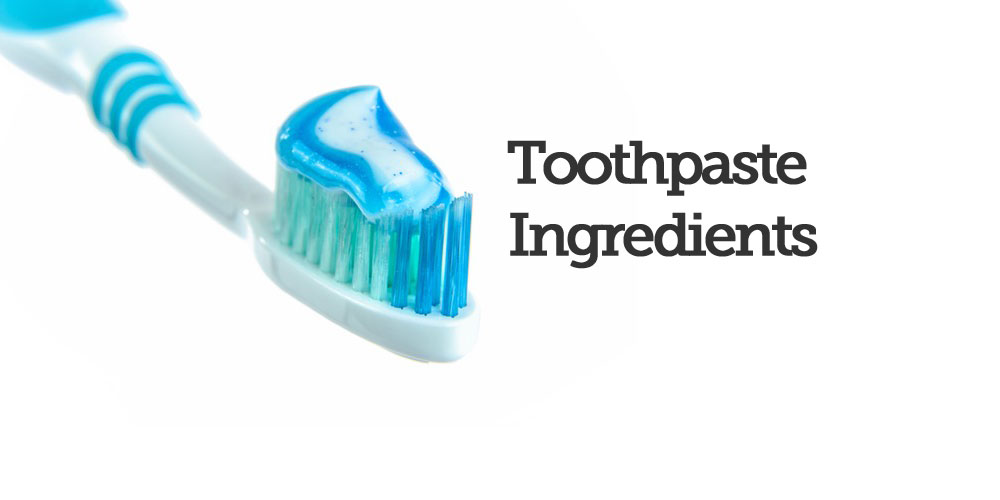Before you buy that next tube of toothpaste you may want to check out the wide range of ingredients it may contain.
But first… a short history on DIY teeth cleaning:
Archaeological finds tell us that ancient Egyptians scrubbed their teeth with a combination of ox-hoof ashes, burnt eggshells and sand as far back as 5000 BC. Later, Romans are known to have used a combination of crushed ox bones and oyster shells, powdered charcoal and crushed tree bark.
And, as recently as the 1700s, the citizens of England were using brick dust and crushed china in their teeth cleaning powders.
Ingredients in Present Day Toothpaste
Abrasives:
These are basically particles which make the action of tooth-brushing more effective. Your toothpaste may contain Silica (made from sand), Alumina (natural or synthetic), Calcium Carbonate (from limestone or shellfish), or Dicalcium Phosphate (synthetic).
None of these compounds would have any cleaning effect on the teeth, whatsoever, without the mechanical action of an accompanying toothbrush.
Detergents:
These create the ‘foaming’ effect and are another cleaning ingredient in toothpaste. They work to dissolve, loosen or breakdown substances on your teeth (plaque, tartar, and stains) so that they may be brushed and rinsed away more easily.
Until recently, the most common detergent in toothpaste has been the synthetic compound Sodium Lauryl Sulfate (SLS) which, according to the American Dental Association, can cause increased gum irritation in people prone to mouth canker sores. SLS is definitely an ingredient of concern for many people and an increasing number of toothpaste formulations do not contain SLS.
Fluoride:
First introduced into toothpaste in 1914, it is arguably its most controversial ingredient. Manufacturers of toothpaste explain that Fluoride strengthens tooth enamel thereby making teeth less susceptible to cavities. True, but opponents of Fluoride argue that its negative effects on whole body health, especially the thyroid gland, far outweigh the purported enamel-strengthening benefit.
Deemed a ‘medicinal’ ingredient, you will find Fluoride in toothpaste in the form of Sodium Fluoride, Stannous Fluoride or Sodium Monofluorophosphate (all synthetic). Fluoride containing toothpastes do not need a preservative as Fluoride also inhibits bacterial growth.
Humectants, Binding Agents and Preservatives:
The combination of these ingredients in toothpaste retains moisture and prevents the toothpaste from separating (as paint does), thereby preventing the need for stirring or kneading before each use.
The most commonly used humectants are Glycerol (from animal sources or petroleum based oils), Propylene Glycol (chemically derived), and Sorbitol (from chemical or natural sources).
Typical binding agents are Carrageenan (seaweed gum), Gum Arabic (sap from the Acacia tree), and Sodium Caboxymethylcellulose/ Magnesium Aluminum Silicate (both synthetics).
Typically, preservatives used in non-fluoride containing toothpastes are Sodium Benzoate (synthetic), Methyl Paraben, or Ethyl Paraben – all gentle antibacterial or anti-fungal agents commonly used in foods, beverages, cosmetics and body care products. The parabens, as they are commonly known, can occur naturally though it is their more widely-used synthetic preparation from petrochemicals which concerns people, like Dr. David Suzuki, most.
Triclosan, another controversial antibacterial ingredient, has just recently been banned, along with 18 other chemicals, by the FDA (in Sept. 2016) over fears that it will create antibiotic resistant strains of bacteria in some people. This order, however, does not take effect until Sept. 2017 so be sure to read the toothpaste label before purchasing, especially if it’s being offered up in large quantities at the dollar store or deeply discounted or “ON SALE” at your local drug or grocery store!
Whitening or Bleaching Agents:
These are either abrasives, like Silica and Mica (natural sources) present in greater amounts in ‘whitening formula’ toothpastes, that help to rub off stains like coffee and red wine… OR they are enzymes, like Glucose Oxidase and Lactoperoxidase (natural and synthetic respectively) that break down the protein in stains like tannins in wine.
Anti-Tartar Agents:
Agents like Tetrasodium Pyrophosphate (synthetic) have shown to prevent the formation of tartar, however they have no effect on existing tartar; a common misconception amongst toothpaste buying consumers.
Sensitivity-Reducing Agents:
Agents such as Potassium Nitrate or Strontium Chloride (both synthetics) basically plug up the open-ended microscopic tubules which make up the dentin of a tooth that has become exposed by gum recession or erosion of the outer enamel of the tooth. Like fluoride, these compounds are considered to be the other ‘medicinal’ ingredient in toothpaste.
Flavouring Agents:
Toothpaste would taste pretty blah if we did not, at least, neutralize the tastes associated with all of the above ingredients, especially the preservatives. For this reason you will always find various natural and artificial flavourings and sweeteners such as Saccharin, Aspartame, or Xylitol – each one of these having their own specific concerns amongst consumers.
Colouring Agents:
These are chemicals, artificial dyes actually, which add the visual appeal to toothpaste. Their formulas are proprietary and examples include Blue 1 and Green D&C#5. Titanium dioxide, another synthetic, is used to colour some toothpastes white.
So, now that we’ve all “brushed up” on the facts as to what’s in toothpaste… are you even more confused than before?
Well, if you are then I’d certainly understand.
I had no idea myself just how many and how ‘different’, sometimes startling, ingredients can be found in the leading toothpastes.
Colgate’s new Enamel Health formula, for example, contains some 20 different ingredients. And of those 20 ingredients only two, Fluoride (NaF) and Potassium Nitrate, are deemed ‘medicinal’ ingredients.
Everything else, then, is non-medicinal ‘filler’ AND the non-medicinal ingredients outscore the medicinal ingredients by a ratio of 9:1!
Who knew?

